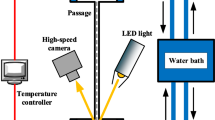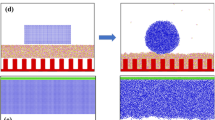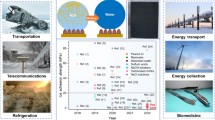Abstract
Dynamic ice making by supercooled water is one of the most promising ways to produce ice slurry at present. However, its main defect is that the supercooler is easy to have ice blockage. A nano-fluorocarbon thin film of about 10 nm thickness coated on the solid surface, which is composed of a large number of uniformly distributed tiny bumps and holes, making the coated surface present super-hydrophobicity and the contact angle θ reach 163.01° with a small contact angle hysteresis. Based on the properties of nano-superhydrophobic surface, the characteristics of flow and heat transfer of supercooled water are analyzed in the flow regime with low reaction coefficient. It was found that: due to the existence of “velocity slip” on the nano-superhydrophobic surface, the flow and average flow rate of supercooled water increase, reducing the mechanical energy dissipation in the process of supercooled water flow, and the flow resistance is smaller with a good heat transfer performance. However, whether the effect of the super-hydrophobic surface can enhance or deteriorate the transport mechanisms depending to the flow regime and surface structure.








Similar content being viewed by others
References
Matsumoto K, Yamauchi H, Teraoka Y (2010) Study on formation of ice slurry by W/O emulsion (discussion for promoting propagation of supercooling dissolution due to DC voltage impression). Int J Refrig 33(8):1590–1597
Kozawa Y, Aizawa N, Tanino M (2005) Study on ice storing characteristics indynamic-type ice storage by using supercooled water: effect of the supplyingconditions of ice-slurry at development to district heating and cooling system. Int J Refrig 28(1):73–82
Wang H, Feng R, Duan H et al (2016) Investigation into the ice generator with double supercooled heat exchangers. Appl Therm Eng 98:380–386
Wang H, He G, Tian Q (2012) Experimental study of the supercooling heat exchanger coated with fluorocarbon coating. Energ Buildings 55(55):526–532
Liu ZQ, Kang W, Liu LQ et al (2016) Dynamic analysis of the formation of ice layer on the subcooler wall. Appl Therm Eng 102:1037–1044
Wang H, Feng R, Duan H et al (2016) Study on sub-cooler based on the characteristics of the super-hydrophobic surface. Exp Thermal Fluid Sci 76:205–210
Traipattanakul B, Tso CY, Chao CYH (2017) Study of jumping water droplets on superhydrophobic surfaces with electric fields. Int J Heat Mass Transf 115:672–681
Wu B, Lu S, Xu W et al (2017) Study on corrosion resistance and photocatalysis of cobalt superhydrophobic coating on aluminum substrate. Surf Coat Technol 33:42–52
Mokhtari S, Karimzadeh F, Abbasi MH et al (2017) Development of super-hydrophobic surface on AL 6061 by anodizing and the evaluation of its corrosion behavior. Surf Coat Technol 324:99–105
Fedeli L (2017) Computer simulation of phase field drops on super-hydrophobic surfaces. J Comput Phys 344:247–259
Bhagat SD, Gupta MC (2015) Superhydrophobic microtextured polycarbonate surfaces. Surf Coat Technol 270:117–122
Long M, Peng S, Deng W et al (2017) Robust and thermal-healing superhydrophobic surfaces by spin-coating of polydimethylsiloxane. J Colloid Interface Sci 508:18–27
Ellinas K, Tserepi A, Gogolides E (2017) Durable superhydrophobic and superamphiphobic polymeric surfaces and their applications: a review. Adv Colloid Interf Sci 250:132–157
Young T (1805) An essay on the cohesion of fluids. R Soc 95(1):65–87
Cassie ABD, Baxter S (1994) Wettability of porous surfaces. Trans Faraday Soc 40:546–551
Shi Z, Zhang X (2017) Contact angle hysteresis analysis on superhydrophobic surface based on the design of channel and pillar models. Mater Des 131:323–333
Lalia BS, Janajreh I, Hashaikeh R (2017) A facile approach to fabricate superhydrophobic membranes with low contact angle hysteresis. J Membr Sci 539:144–151
Escobar JV, Garza C, Alonso JC et al (2013) Super-mercuryphobic and hydrophobic diamond surfaces with hierarchical structures: Vanishment of the contact angle hysteresis with mercury. Appl Surf Sci 273(2):692–701
Taurino R, Fabbri E, Messori M et al (2008) Facile preparation of superhydrophobic coatings by sol-gel processes. J Colloid Interface Sci 325:149–156
Knüpfer P, Ditscherlein L, Peuker UA (2017) Nanobubble enhanced agglomeration of hydrophobic powders. Colloids Surf A Physicochem Eng Asp 530:117–123
Ditscherlein L, Fritzschea J, Peuker UA (2016) Study of nanobubbles on hydrophilic and hydrophobic alumina surfaces. Colloids Surf A Physicochem Eng Asp 497:242–250
An H, Liu G, Craig VS (2015) Wetting of nanophases: Nanobubbles, nanodroplets and micropancakes on hydrophobic surfaces. Adv Colloid Interf Sci 222:9–17
Attard P (2003) Nanobubbles and the hydrophobic attraction. Adv Colloid Interf Sci 104(1):75–91
Sookhak Lari K, van Reeuwijk M, Maksimovic C (2013) The role of geometry in rough wall turbulent mass transfer. Heat Mass Transf 49(8):1191–1203
Choi KS (2006) Fluid dynamics: the rough with the smooth[J]. Nature 440(7085):754
Jin Y, Herwig H (2015) Turbulent flow in rough wall channels: validation, of RANS models. Comput Fluids 122:34–46
Lauga E, Brenner M, Stone H (2007) Microfluidics: the no-slip boundary condition. Springer, Berlin Heidelberg
Inada T, Yabe A, Grandum S et al (2000) Control of molecular-level ice crystallization using antifreeze protein and silane coupling agent. Mater Sci Eng A 292(2):149–154
Acknowledgements
The present study was supported by the Doctoral Fund Project of Henan Institute of Engineering (No. D2014003). The authors also would like to thank the analytical testing center of Henan Institute of Engineering for providing the measuring support.
Author information
Authors and Affiliations
Corresponding author
Additional information
Publisher’s Note
Springer Nature remains neutral with regard to jurisdictional claims in published maps and institutional affiliations.
Rights and permissions
About this article
Cite this article
Wang, H., Wang, Y. The flow and heat transfer characteristics of supercooled water based on the nano-superhydrophobic surface. Heat Mass Transfer 55, 413–420 (2019). https://doi.org/10.1007/s00231-018-2424-1
Received:
Accepted:
Published:
Issue Date:
DOI: https://doi.org/10.1007/s00231-018-2424-1




